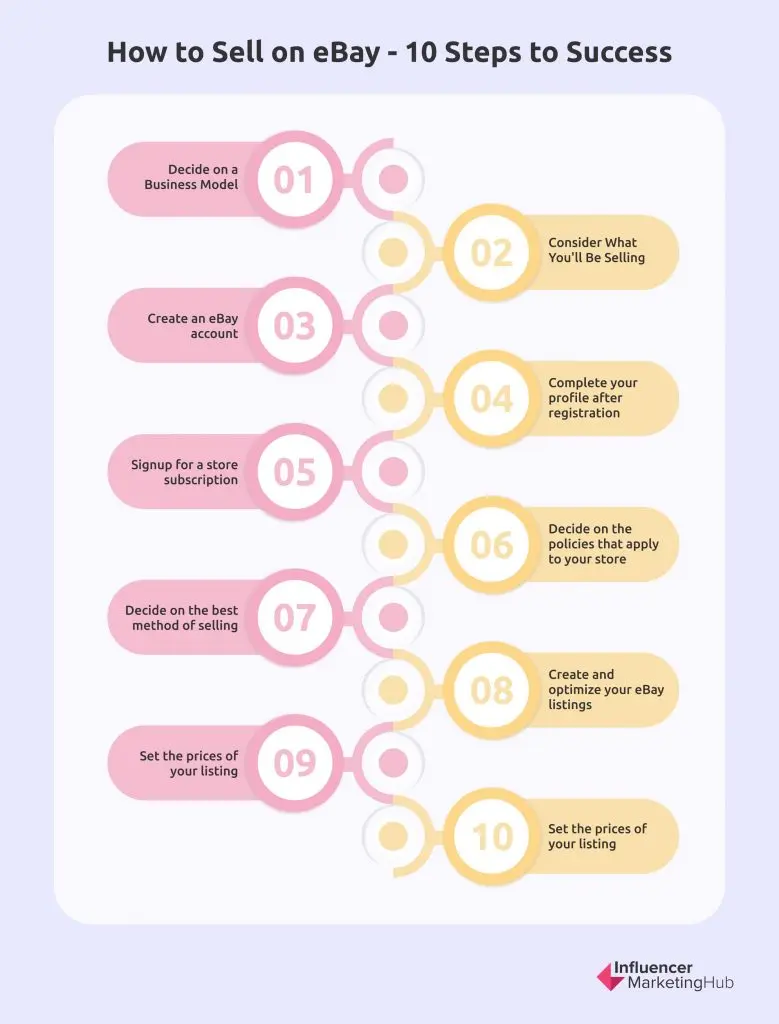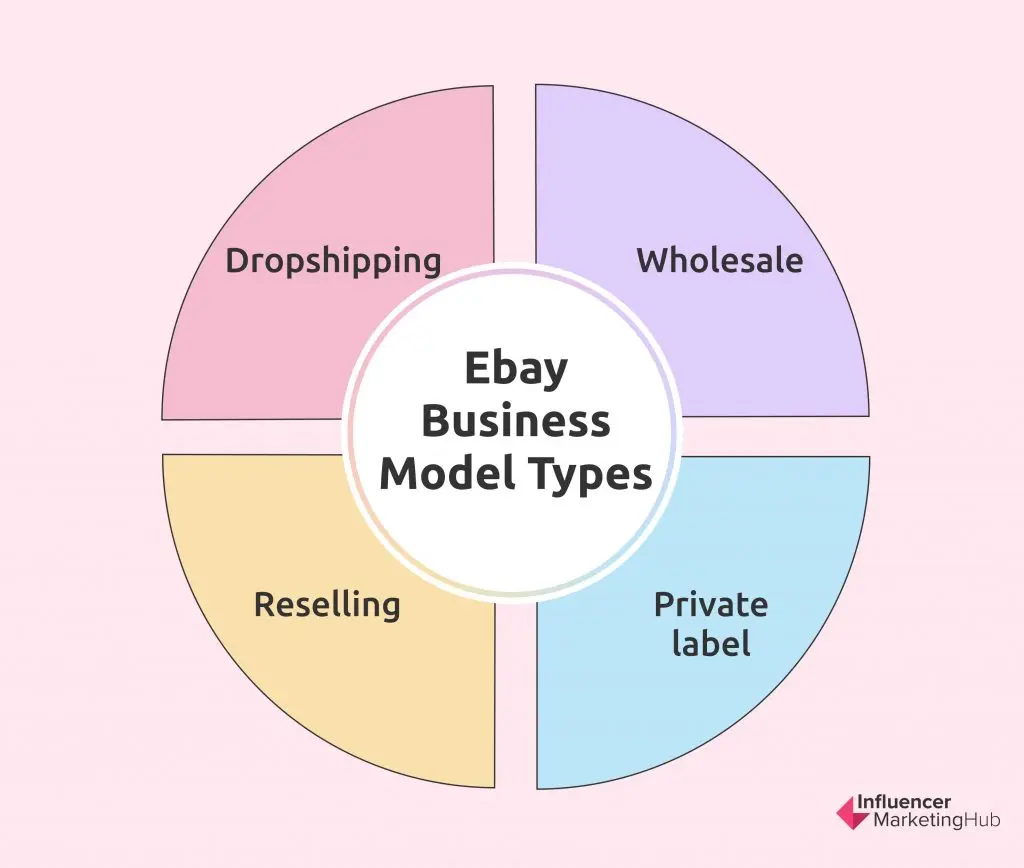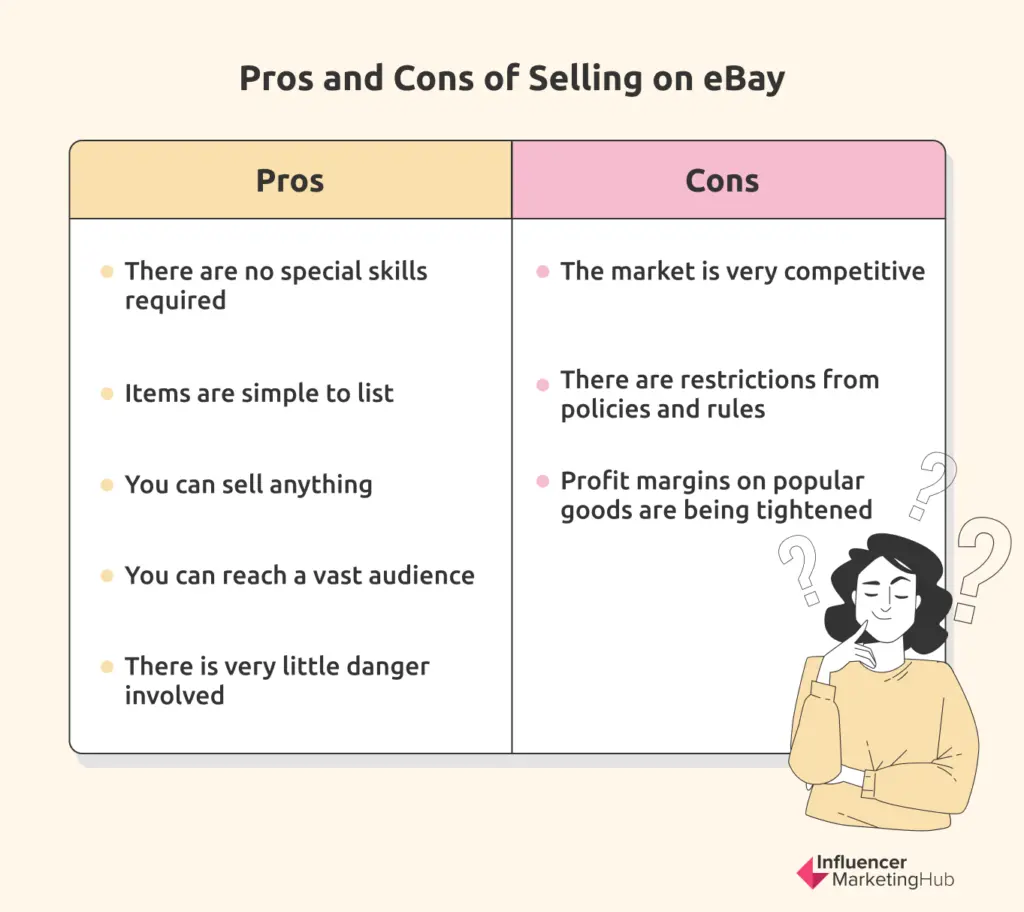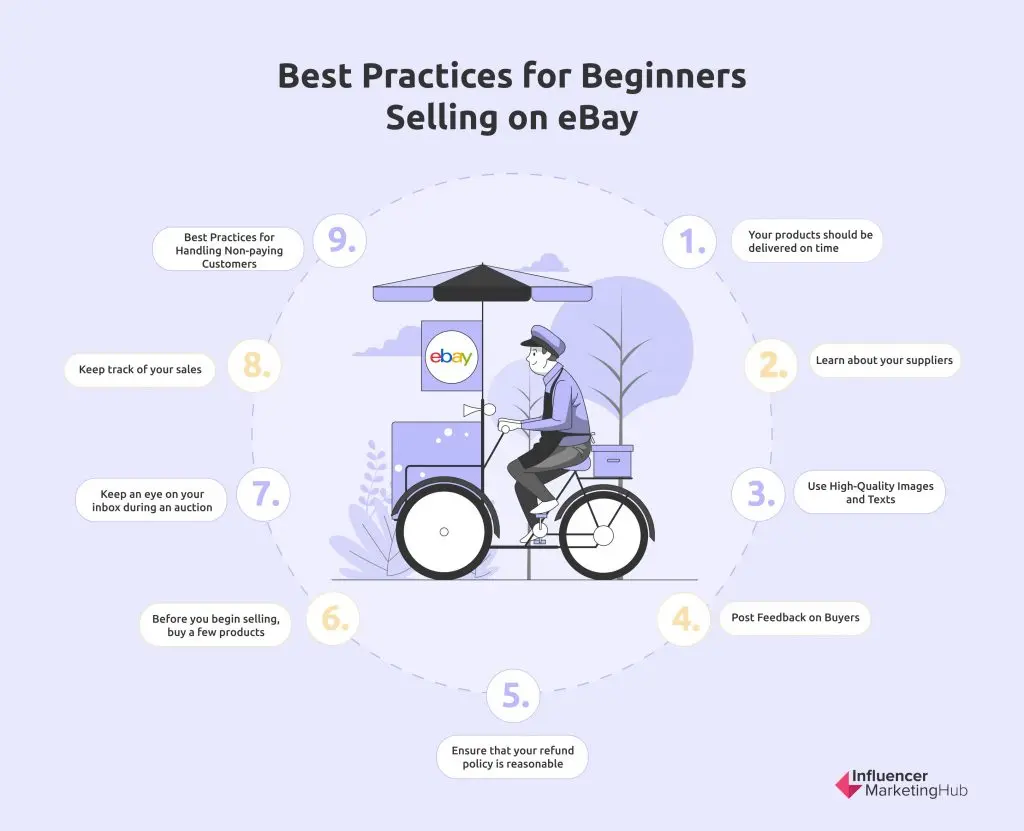It's no secret that eBay is a great e-commerce platform with millions of users across the world. A seller on eBay can tap the potential of their large global audience, but at the same time, competition is stiff— especially for beginners who are looking to start from scratch.
As a newbie on the platform, it can be difficult to know where to begin and how to get customers to buy from you. While it is possible to build a profitable online business on eBay, you still need meticulous planning and execution.
In this beginner’s guide, we will give you a brief introduction to the platform and a comprehensive step-by-step guide on how to sell on eBay including the pros and cons you should expect.
How to Sell on eBay in 2024:
What is eBay and How Does It Work?
eBay, which was established in 1995, is an e-commerce website best known for its auctions and direct sales to consumers.
A large number of countries throughout the world use eBay. By entering your zip code, you can search for goods that are available in your local region. You can also do a search for items that are available both nationally and globally.
There are fees sellers are required to pay, such as listing fees. The fees vary based on the price at which you sell your products and the length of time you keep them on the market.
You can sell almost any item on eBay; from antique pieces to vehicles, books, toys and more. When you put an item up for sale, you can choose between the auction-style listing and the “buy it now” option. An auction-style listing allows you to accept just bids, while a buy it now option lets customers pay a fixed amount for the item right away.
An online auction also begins at a predetermined price and lasts for a specified time. Bids are then placed by interested parties. At the end of the auction, the highest bidder is the winner. In a buy it now listing, the item goes to the first person who offers to pay the seller's price.
How to Sell on eBay
138 million active buyers throughout the world can be reached through eBay's global marketplace, which operates in more than 190 countries. In order to assist its sellers and compete in the digital commerce market, eBay develops specialized training and programs as well as new tools and products to make selling and reaching more consumers easier.
If you're just starting out, learning the basics of how to sell on eBay in this guide will get you well on your way to making your very first sale.
1. Decide on a Business Model
Beginning your eBay career with a solid business model is vital. As you will utilize this plan to provide value for your customers while also making money. There are a variety of business models to choose from, including:
Wholesale
In this category, a large quantity of items is purchased at a low price then sold individually at a much higher price for profit. You save money by buying in bulk since wholesalers provide discounts for large quantity purchases.
Private label
This is done by purchasing non branded items which are then customized with your own brand. You can buy non branded items from overseas at a cheaper price or contact private label manufacturers so you can resell these items without the cost of making them.
Reselling
It is possible to buy branded goods from physical or online stores and resell them on eBay via arbitrage. The reseller business model is suitable for new eBay sellers since you wouldn’t have to worry about contacting wholesale manufacturers.
Dropshipping
Dropshipping is a fairly new business model with the potential to generate substantial earnings for new sellers. This business model involves getting orders from your customers and coordinating these orders with a third party supplier, who then packages and ships the orders directly to your customers. This model means you wouldn’t have to deal with managing inventory or the actual shipping.
2. Consider What You'll Be Selling
After choosing a business model, the next step of getting started on how to sell on eBay is to decide the type of products you will be selling on the platform. Most sellers begin with products that fit into one of the top-performing categories. Some of these categories include:
- Home and garden
- Health and beauty
- Crafts and arts
- Toys and hobbies
- Sporting products
- Computer and networking
- Pet supplies
- Antiques
- Mobile phone accessories
Research your product category thoroughly before putting any items up for sale. To increase your chances of success, select a category that you are experienced or enthusiastic about. Keep in mind that a solid choice should meet these three requirements:
Low level of competition
If you're new to learning how to sell on eBay, bear in mind that the less competitive a niche market you choose, the more money you have the potential of making.
It solves a problem
For customers to keep buying from you, your product should provide value and at least solve an issue. If it is useful, customers would likely be enthusiastic about it. You'll be able to help more people and make money at the same time.
Generates a good amount of profit
You’ll have to pay a percentage for every purchase you make on eBay. Remember to factor that into your price set-up. Aim for a price point of $10 to $75 to maximize your return on eBay sales.
3. Create an eBay account
Creating an eBay account is simple. Once you visit their main site, there is an option to register or sign in at the top left corner of the homepage.

Source: ebay.com
Simply click the “Register” button to get started creating your own personal account. eBay asks for some basic information such as your name, address, and phone number during the process.

Source: ebay.com
This page also gives you the option of creating a business account if you intend to sell on eBay under a business name. However, you'll need to submit official business credentials.

Source: ebay.com
When you're signed into eBay, you can see all of your selling choices by clicking on "seller dashboard."
4. Complete your profile after registration
It’s helpful to provide an image and a brief description of yourself in your profile. When you’re logged into eBay, all you have to do is click on your name in the upper-left corner of the website. By clicking on your avatar, you will be able to make changes to your profile information.
When you sign up for an eBay account, a user ID is provided. eBay customers are more likely to trust you if you include your personal or business name. To do this, go into your “My eBay” account and navigate to the “My Account” section.
Select 'Personal information' from the option that appears. Here, you can update your username and provide links to your social media accounts, in case your customer wants to know more about your brand.
5. Signup for a store subscription
Signing up for a shop subscription on eBay is a great way to develop your brand. As part of an eBay store package, you can save money on fees and get more free listings each month. In addition, you'll get plenty of marketing tools to help you find new customers.
To receive payments, you'll need to link a checking account. Make sure you understand the different store features and prices before signing up.
An eBay Store subscription costs $4.95 per month if you can sell up to 250 products each month. After that, for $21.95 a month, you may add 1,000 listings and pay lesser final value costs. Users with more sales can subscribe to eBay for $59.95 per month.
You'll be given a chance to name your eBay storefront when you subscribe to any of the packages mentioned above.
6. Decide on the policies that apply to your store
eBay will require you to provide information about delivery, payment, and return policies when you post an item. These policies can considerably impact your costs, revenues, consumer happiness, and reviews.
Payment options
Most vendors are able to accept payments on eBay using different options. These include credit cards, debit cards, Google Pay, Apple Pay, and PayPal.
Shipping policies
You can specify your shipping date, time, and methods of delivery in this section. Do your best to match eBay's free shipping offer after you sell 71% of your products. If you sell bulky items, consider an alternative delivery method to avoid breakage or returns.
Returns
Specify whether or not you accept returns in this section. If you do, be sure to include the number of days customers are allowed to return purchased items, and the person or company responsible for the shipment. A reasonable return policy can make your business appear more credible and help you avoid customer disputes or dissatisfaction.
7. Decide on the best method of selling
You can choose between the set price or an auction method. With fixed-price items, there is a set fee and products under this category can be displayed for up to 30 days. For the auction method, several individuals can place bids on the same item in an auction for a certain period, usually three to 10 days.
Items that appeal to a particular market but don't have a fixed retail price can be auctioned, such as antique goods or designer clothing.
8. Create and optimize your eBay listings
A simple click of the "Sell" button at the top right of any eBay page will allow you to create a new listing. For eBay to immediately fill your listing, you will be required to input a product ID or name.
Incorporate information from the product category and its associated image, title, description, and any other relevant details. Also consider these other points to optimize your listings.
Keywords
Take a moment to consider the keywords and phrases people will input in the search box to look for the items you sell. You'll have a higher chance of being noticed on eBay if you include more searchable keywords in your product's title and description. You can also use one of the numerous tools offered by third party sites like Heluim10 to conduct in-depth keyword research.
Product Information
Make sure you provide enough information in your listing and description so that buyers can make an informed selection. Add features and points such as the material used, color, dimensions, and the brand name in the product description section.
9. Set the prices of your listing
Setting the right product price is essential to ensuring profit. View past auctions to get a sense of how much other sellers sold items similar to yours. To get a good idea of how much people are willing to pay for identical items on eBay, it’s helpful to look through recently finished listings.
To do this, type the name of the item in the search box, then check the "completed products" box in the sidebar. If an item has recently been sold, you'll be able to see how much customers paid for it.
10. Build relationships with customers
The relationship between you and a customer begins when they place an order for your products. A solid relationship with your customers will positively impact your business. If your customers are happy, they're more inclined to return to your store and send referrals to your business.
The more positive feedback you receive, the higher your seller rating will be, and having a good seller rating means a higher ranking in search results.
Pros and Cons of Selling on eBay
Just like all e-commerce platforms, selling on eBay also has its advantages and demerits. As a prospective seller, it’s important you get yourself acquainted with the pros and cons of the platform.
Tips and Best Practices for Beginners Selling on eBay
As a new seller on eBay, here are some tips and best practices to keep in mind.
-
Your products should be delivered on time
Today's technologically advanced society demands immediate satisfaction and speed. As an e-commerce store owner, you should strive to fulfill orders and process payments as promptly as possible. Use a system that ensures customers' goods are shipped within a 24 to 48-hour window after payment.
Glitches during payment or late delivery will likely aggravate customers. Respond to queries on time and let your customers know the status of their order fulfillment. Your client should be notified if there are any significant delays in the item's delivery.
-
Learn about your suppliers
Without a product to sell, your business won’t generate profit. Coordinate closely with your manufacturers and distributors to ensure a smooth supply chain.
It is possible to save a significant amount of time and money if you are aware of slow seasons, shipping issues, and other unique challenges ahead of time.
-
Use High-Quality Images and Texts
Use high-quality pictures while adding your listings. High-quality images catch the attention of potential customers and make you appear trustworthy while boosting your sales.
To shoot high quality images of your products, invest in a high-resolution camera or a camera phone. You are permitted to upload up to twelve images on eBay for free. Publishing between nine and 12 photographs is enough to show your customers the product from different angles.
-
Post Feedback on Buyers
Using the feedback system on eBay, you can leave a comment on any registered profile. Sellers can benefit from positive feedback ratings since they make them appear more credible to potential buyers. You'll get more positive feedback if you show your responsiveness to every customer.
This feedback system benefits not just the seller but buyers as well. A buyer with good feedback tells other sellers they are worth the seller’s effort.
-
Ensure that your refund policy is reasonable
All sellers are legally obligated to provide a return policy as part of the eBay guarantee. eBay will reimburse the buyer if an item delivered isn't as described in the listing. If you want to encourage a buyer to choose you, there are various ways you can entice them using your refund policy.
Sellers with a return policy of at least 30 days are given preference in search results by eBay. Buyers sometimes look for suppliers who have return policies in place since they can easily return damaged products. Sellers that refuse to offer refunds may be perceived as dishonest.
As a seller, you might be concerned about receiving a refund request and losing money after shipping an item. This shouldn’t be a major concern as the vast majority of customers who want a refund do not return the goods they receive, which leads eBay to cancel their refund claims.
-
Before you begin selling, buy a few products
If you are entirely new to the eBay platform, start by making a few purchases, pay right away, and then provide feedback to the seller. You will also receive feedback as a buyer and start building your reputation. This can further improve customer trust in you when you post your own listings.
-
Keep an eye on your inbox during an auction
If a customer has a query regarding an item you've posted, they might want to ask you via private message—which would be best to respond to as quickly as possible.
If they have a question regarding an item, you will be able to either respond to them one-on-one or publish your answer to the item's listing so that others who may have the same questions would be clarified.
-
Keep track of your sales
If you want to build a long-lasting business on eBay, keep track of your profits and costs to determine your cumulative gross and net income. Include packing supplies, the amount you paid to buy each item, postage fee, mileage, and other business-related miscellaneous expenses.
All invoices and sales receipts you send to your clients should be copied. One copy will go with the delivered package while the other should be kept in your personal file. There are analytic tools offered by services like Helium10 to help you keep accurate track of your expenditure.
-
Best Practices for Handling Non-paying Customers
As a new seller on eBay, you might need to deal with non-paying customers at some point, like the occasional bidder who won your listed item but refuses to pay. Not to worry, as there are ways you can avoid this.
First, start by sending a notification by an automated system alerting the buyer that they've won the auction and that they must now pay.
Before sending out a product, wait until you’re paid for it. If the prospective buyer hasn't responded to your invoices after a few days, you can submit a dispute with eBay. Following the proper steps helps prevent getting charged a selling fee for an item you never received money for.
Frequently Asked Questions
How does an eBay business account differ from a personal account?
While setting up an account on eBay, sellers have the option of selecting between a business or a personal account. Unlike a personal account, the business account tab is only available for legal entities in the United States.
It offers you options such as an opportunity to register your brand name, which can be incorporated into different documents like invoices. There are options for increasing selling limits and you can gain access to sale tools to grow your business.
I created a listing but why isn’t it posted?
There are various reasons why your listings are not being posted, but the most common ones include:
- Your account has reached its limit
- You forgot to click on the sell button after listing
- Not enough information about your listing.
- There is no category for your product (you can add it manually in this case)
- There is no fixed price for the listing
- The shipping option violates a rule
Should I build my own eBay template or buy one?
To create an eBay HTML template, you have the option of designing one yourself if you have the technical expertise. If not, you can invest in a more professional template.







